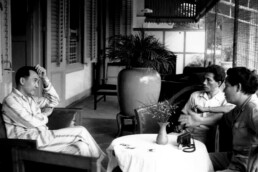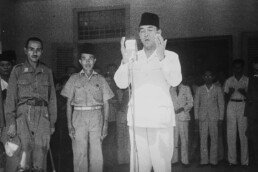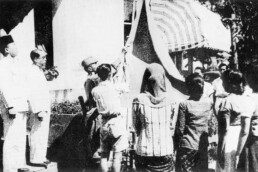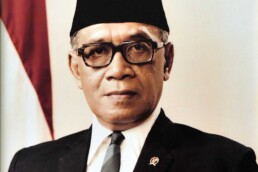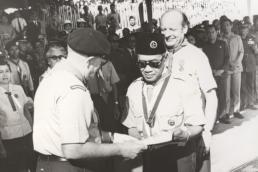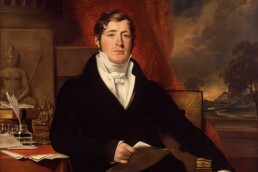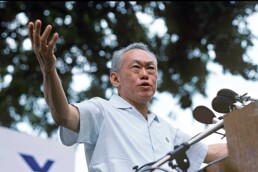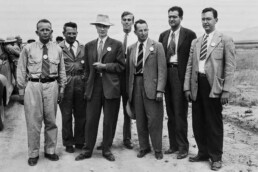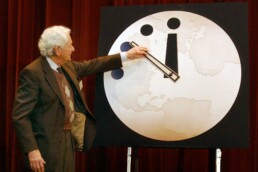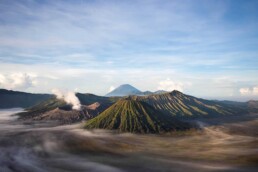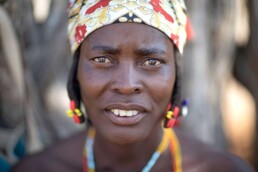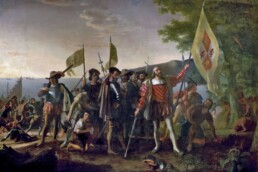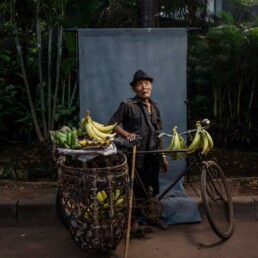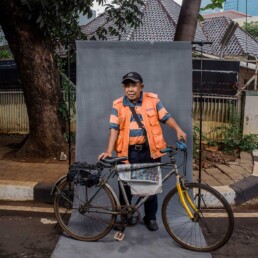Capturing History with the Courageous Mendur Brothers
In the annals of history, few have captured the essence of a nation’s struggle and triumph as poignantly as Alex and Frans Mendur. These two brothers, armed with their cameras, played a pivotal role in documenting Indonesia’s fight for independence. Their photographs not only preserved crucial moments of history but also fueled the spirit of a burgeoning nation. This article delves into their lives, their invaluable contributions, and the enduring legacy they left behind.
Alex and Frans Mendur were born in Kawangkoan, a small town in North Sulawesi. From a young age, both brothers exhibited a keen interest in photography, a passion that would later define their lives and place them at the heart of Indonesia’s historic transformation. Their journey into the world of photography began in earnest when they moved to Java, where they joined the prominent Japanese news agency, Domei Tsushin. This position provided them with the skills and opportunities that would eventually make them iconic figures in Indonesian history.
The Mendur brothers’ most significant contribution came during the Indonesian struggle for independence. As the country teetered on the edge of liberation from Dutch colonial rule, Alex and Frans found themselves in the midst of the action, their cameras poised to capture history. Their most notable work emerged on August 17, 1945, the day of Indonesia’s Proclamation of Independence. In the sweltering heat of that historic day, Sukarno and Mohammad Hatta declared Indonesia’s independence, a moment immortalized by the Mendur brothers’ lenses.
Capturing this proclamation was no small feat. The Japanese occupiers, who were still present in Indonesia, imposed strict controls on the press. Photography was heavily monitored, and any material deemed subversive was subject to confiscation. Despite these risks, Alex and Frans were determined to document the proclamation. They had to work clandestinely, hiding their cameras and smuggling their films to safety. The images they captured not only depicted the euphoria of the moment but also served as a powerful tool of resistance and a symbol of hope for the Indonesian people.
The challenges did not end with the proclamation. Preserving these photographs was equally perilous. The Mendur brothers faced constant threats from Japanese and Dutch forces who sought to suppress any material that could incite nationalist sentiments. They had to hide their negatives in ingenious ways, often burying them to avoid detection. Despite these immense risks, their dedication ensured that these pivotal moments were not lost to history.
Following Indonesia’s hard-won independence, Alex and Frans Mendur continued to contribute to the nation’s burgeoning journalistic landscape. They co-founded the Indonesian Press Photo Service (IPPHOS), which became a cornerstone of Indonesian photojournalism. Through IPPHOS, the Mendur brothers mentored future generations of photographers, instilling in them the same passion and commitment that had driven their own work.
The brothers’ photographs, especially those from the proclamation, became iconic symbols of Indonesia’s independence. Their images were not just historical records; they were imbued with the spirit and struggles of a nation. These photographs were featured in newspapers, magazines, and history books, shaping the narrative of Indonesia’s fight for freedom. The Mendur brothers’ work received numerous accolades, and they were recognized as pioneers of Indonesian photojournalism.
The legacy of Alex and Frans Mendur extends beyond their photographs. Their work has had a lasting influence on the field of photojournalism in Indonesia. They demonstrated the power of photography as a tool for social and political change, inspiring countless photographers to follow in their footsteps. Museums and exhibitions around Indonesia continue to showcase their work, ensuring that new generations can appreciate their contributions.
Personal stories and anecdotes about the Mendur brothers further illuminate their characters and the profound impact of their work. They were known not just for their skill with a camera but also for their unwavering dedication to their country. Friends and colleagues often spoke of their bravery and resourcefulness, qualities that were essential in the tumultuous times they lived through.
In conclusion, Alex and Frans Mendur were more than photographers; they were chroniclers of a nation’s birth and its tumultuous journey towards freedom. Their images captured the essence of Indonesia’s struggle and the spirit of its people. Through their lenses, they preserved moments that might have otherwise been forgotten, providing future generations with a visual narrative of their country’s history. The Mendur brothers’ legacy is one of courage, dedication, and an unyielding commitment to documenting the truth. Their contributions continue to resonate, reminding us of the power of photography in shaping and preserving history.
The Visionary Sultan's Behind Pramuka
The rhythmic chanting of excited young voices rises in the middle of Indonesia, bearing with them the adventure and friendship. These voices come together on August 14th to honour the ongoing heritage of Indonesian scouting on Pramuka Day. Derived from “Praja Muda Karana,” which means “young people willing to work,” Pramuka represents resiliency, patriotism, and the search for knowledge. To really appreciate Pramuka, though, we must return to the idea of its founding father, Sri Sultan Hamengkubuwono IX.
Born Raden Mas Dorodjatun, Sri Sultan Hamengkubuwono IX was not only a revered person in Indonesian history but also the visionary who planted Pramuka. Born in the Yogyakarta Sultanate in 1912, he received his education in the Netherlands, where he came across the worldwide scouting movement. Inspired by the ideas of Baden-Powell, the creator of the worldwide Scout organisation, Hamengkubuwono IX imagined a comparable program that might inculcate among young people of Indonesia unity, discipline, and patriotism.
Pramuka started his trip in the stormy years preceding Indonesia’s independence. The archipelago was rife with colonial tensions and fervent liberation movement activity. Against this background, the concept of a scouting movement evolved as a tool for developing national identity and leadership. Deeply committed to the cause of Indonesian freedom, Hamengkubuwono IX considered Pramuka as a necessary instrument in fostering a unified national character.
Gerakan Pramuka Indonesia was founded in 1961 by the official recognition of the scouting movement by the Indonesian authorities. Years of work and campaigning by Hamengkubuwono IX and other nationalists who saw the value of young organisation in national development came to pay off at the launch. The first ceremony took place at the Istana Negara, where President Sukarno formally presented the national flag to the young delegates, therefore initiating Pramuka.
The qualities of self-reliance, community service, and environmental preservation define Pramuka’s ideas rather thoroughly. The movement stresses learning by doing and pushes scouts to participate in a range of outdoor events promoting collaboration and useful skills. From community service initiatives to camping and hiking, these events are meant to help build character, resilience, and social responsibility.
The effect of Sri Sultan Hamengkubuwono IX on Pramuka transcends its early years. His life itself was evidence of the principles Pramuka advocates. He was instrumental in defending Yogyakarta’s cultural legacy from Japanese invaders throughout World War II. Later, serving as Indonesia’s vice president, he supported youth projects and education so that Pramuka’s values stayed fundamental for the country’s growth.
Pramuka has a major influence on Indonesian society. It has turned out generations of leaders carrying forward the flame of national pride and service. From busy metropolis to far-off villages, the movement now comprises millions of people across the island, drawn by the shared objective of improving Indonesia. Reflecting the scout motto of “Be Prepared,” Pramuka has also been very important in disaster relief and community building.
Pramuka Day reminds us annually of the movement Sri Sultan Hamengkubuwono IX helped start and his ongoing legacy. This is a day when scouts all throughout the country restiter their dedication to the scouting values and the vision of a united, self-reliant Indonesia. Reflecting the attitude of unity and group work, the celebrations are observed with rituals, parades, and community service events.
Pramuka’s values are still as important today as they were years ago as the world is fast changing. Staying faithful to its basic ideas, the movement keeps changing to fit the demands of contemporary society. It gives young Indonesians a stage on which to grow leaders, strengthen their feeling of community, and help their country to flourish.
In honour of not just the historical path of the scouting movement in Indonesia but also the everlasting vision of its founding father, Sri Sultan Hamengkubuwono IX, as we celebrate Pramuka Day Millions of scouts who want to live by ethics, service, and patriotism carry his legacy with them. Through Pramuka, the youthful energy of Indonesia keeps shining brilliantly, guiding us towards a time of harmony and prosperity.
Singapore's Journey from Colonial Outpost to Global Icon
Singapore’s rise from a small trade post to a thriving global city-state is one of the most amazing stories in history. Sir Stamford Raffles started this change in the early 1800s. It is a story of strategic planning, colonial ambition, and unwavering determination. In 1819, Sir Stamford Raffles, who was the British Lieutenant-Governor of Bencoolen, arrived on an island that didn’t look like much. Raffles was interested in Singapore because it was in a good spot, right at the intersection of important sea lines. He saw that the island could be a major trade hub. His goal was to make a free port, a place where ships from all over the world could dock without having to pay a lot of taxes and fees. With this plan, Singapore was to become a key part of Britain’s power in Southeast Asia. Raffles’ risky move set the stage for a time of growth that had never been seen before.
Singapore changed quickly and deeply while it was ruled by the British. With the promise of better economic opportunities, people from China, India, and the Malay Archipelago came to the island, making it bigger. By the middle of the 1800s, Singapore had changed from a quiet village to a busy port for ships from all over the world. The streets, which used to be just paths for walking, were now packed with shoppers, workers, and newcomers. The town’s infrastructure grew quickly, with important facilities like roads, docks, and public buildings being built quickly. This set the stage for Singapore’s future success.
At the start of the 20th century, Singapore’s growth didn’t stop, but it wasn’t all smooth sailing. Because the island was so important strategically, it was a target during World War II. In 1942, Japanese troops took over Singapore and changed its name to Syonan-to. During the Japanese rule, life in Singapore was very hard and people were suffering. But it also brought people of different ethnic groups together and stoked their pride.
When World War II ended, Britain took back control of Singapore. However, the years after the war were marked by rising unrest and calls for self-government. Asia was being freed from colonial rule, and Singapore’s government began to change. Leaders in the area led the fight for independence because they wanted to express their right to choose for themselves. The first general elections in Singapore were held in 1955. This was a big step towards independence. As soon as the new government was formed, the People’s Action Party (PAP), led by Lee Kuan Yew, started making changes to solve social problems and raise living standards.
Not everything was easy on the way to full freedom. Singapore had problems with its economy, its government, and its communities. By making a bigger economic and governmental unit through the merger with Malaysia in 1963, these problems were tried to be fixed. But the union had a lot of problems, and in 1965, Singapore was kicked out of Malaysia and became its own country.
The years after Singapore got its freedom showed how strong and forward-thinking its leaders were. The city-state began an amazing journey of building a country under the leadership of Lee Kuan Yew and those who came after him. With a strong focus on education, economic growth, and public homes, the government worked hard to make Singapore a modern, industrialised country. Singapore’s growth into a global financial hub was made possible by investments in technology and infrastructure.
Singapore is a shining example of progress and wealth today. Its skyline, which is made up of famous buildings like Marina Bay Sands and the Gardens by the Bay, shows how well the city-state has done at combining old and new ideas. Singapore is a model of growth in the 21st century because of its strong economy and dedication to social harmony and cultural diversity.
Looking back, Singapore’s history from a strategic trading post to a free and successful city-state is an interesting story of vision, flexibility, and drive. Through this story, we can see how strategic planning and the unbreakable spirit of a nation’s people can change its future. Singapore has grown from Sir Stamford Raffles’s original idea to the busy global city it is now. Its growth shows what can happen when ambition meets chance.
The Art of Travel Fatigue: Capturing Creativity Across Time Zones
For many photographers, the allure of photographing faraway scenery and different cultures means crossing multiple time zones, which can be very hard because of jet lag. This effect, which is marked by feeling lost and tired after quickly travelling through different time zones, can be especially bothersome for workers who need to be able to concentrate and think creatively. Even though it’s hard on your body, learning how to deal with jetlag can turn a difficult problem into a chance to be more productive and creative.
The body’s internal clock, or circadian rhythm, has a hard time adjusting to a new time zone, which causes jet lag. If this isn’t aligned properly, it can cause problems like trouble sleeping and thinking clearly, both of which make it harder for a shooter to do their best work. But getting over jet lag isn’t just about getting used to a new schedule; it’s also about taking a proactive attitude to your physical and mental health.
To start, getting ready is very important. Changing your sleep plan before you leave can make the change a lot easier. Gradually changing when you go to bed and wake up to match the time zone of your destination helps your body get used to the new rhythm, which makes jetlag less severe when you get there. Furthermore, drinking plenty of water and staying away from alcohol and coffee during the flight can help you stay energised and sleep better.
When you get to your destination, the surroundings can help a lot with getting over jet lag. One of the best ways to reset the internal clock is to be in natural light. Photographers who are used to working with different kinds of light can use this to their advantage by planning shoots outside during the day. The light in the morning can help the body adjust to the new time zone even more, which can help you get over jet lag faster.
Having a regular routine can also help you deal with the effects of jet lag. Setting regular times for meals and doing light exercise, like going for a walk or doing stretching exercises, can help you feel better and be more aware. For photographers, doing these things along with their work—like scouting sites or taking pictures of local scenes—can help them stay focused and get work done even when they have to deal with time zone changes.
A keen mind and sharp feelings are needed for creativity, which is often the most valuable thing about a photographer. It is important to keep a good attitude and deal with stress so that jet lag doesn’t stop you from being creative. Deep breathing and meditation are two mindfulness methods that can help with this. Photographers can stay focused and inspired by taking breaks for quiet and thought. This can turn possible fatigue into a fresh look at their work.
When it comes to photos, jet lag can be very helpful. It’s possible for tiredness to change your state of mind, which can sometimes lead to new ideas and songs. Accepting this change in how people see things lets shooters find new angles and catch moments that they might miss otherwise. Also, having to change with the times can make you more resilient and adaptable, which are skills that help your career and personal growth.
Additionally, working together with local teachers or other photographers can be very helpful. Even though jet lag can be hard, local experts can help you get the most work done by telling you the best times and places to shoot. Getting involved with the local society and talking with other people who work in the same field can also inspire and motivate you.
Photographers face a huge task when they’re jet lagged, but it’s also a chance to become stronger and more creative. Photographers can deal with the challenges of travelling and still stay true to their artistic vision by learning how to control its effects and enjoying the unique views it offers. As they take pictures of the world, the things they learn about dealing with jet lag become a part of their trip, making their work better and broadening their views.
The Doomsday Clock Reveals About Our Future
Moments of great importance in the annals of human history are sometimes distinguished by symbols that capture the spirit of their times. The Doomsday Clock is one such emblematic tool meant to mirror the imagined threat of world disaster. Designed by the Bulletin of the Atomic Scientists in 1947, the Clock has evolved into a vital gauge of human susceptibility to existential hazards ranging from nuclear conflict to climate change.
The devastation caused by World War II and the later arrival of nuclear weapons helped shape the Doomsday Clock. Comprising academics and scientists from the Manhattan Project, the Bulletin of the Atomic Scientists aimed to convey the dangerous situation of world events as the Cold War started. The Clock was thus born as a symbolic tool, its hands creeping towards midnight to indicate a growing likelihood of world catastrophe.
Originally scheduled for seven minutes to midnight, the Clock’s placement has been changed several times in response to the shifting terrain of environmental concerns and world affairs. Every change captures the collective assessment of the most urgent threats facing the planet. During times of increased suspense, like the Cuban Missile Crisis, the hands have ticked closer to midnight; they have also retreated during times of relative calm.
The symbolism of the Clock transcends nuclear dangers. It has also included additional worldwide hazards in recent years: climate change, biological hazards, and new technology. This more general approach recognises that existential dangers affect a variety of elements endangering the destiny of the earth rather than limited to the domain of nuclear war.
The Clock’s changes mirror a growing worry about climate change. The Bulletin has often moved the hands towards midnight as scientific evidence of global warming mounts, underlining the need of tackling environmental damage. Rising sea levels, severe storms, and loss of biodiversity—all of which are effects of climate change—cause great hazards to world stability and human well-being. The Clock reminds us strongly of the need of group effort to reduce these hazards.
Including other worldwide hazards into the Clock’s equation shows how linked modern hazards are. Emerging technologies bring fresh questions especially in the fields of artificial intelligence and biotechnology. The possibility for abuse or unanticipated results of these developments complicates the scene of world risk. The changes made by the Clock reflect these changing issues and underline the need of proactive measures in many spheres since protecting the future calls for awareness.
Beyond its symbolic depiction, the Doomsday Clock has influence. It draws attention to important concerns and motivates public and governmental reactions, therefore acting as a catalyst for communication and action. The Clock has become a potent weapon for increasing awareness and pushing for change by converting abstract dangers into a concrete metric. Its appearance in media and scholarly debates emphasises the need of ongoing efforts to solve world problems and support environmentally friendly solutions.
The Doomsday Clock is not without controversy even if its great importance is undeniable. Some contend that its symbolism either oversimplifies difficult problems or encourages a fatalism. Others argue that its vivid depiction of risk could eclipse small but significant advancements towards the resolution of world concerns. Still, the Clock is a moving emblem of the need of group accountability and planning.
The Doomsday Clock is both a warning and a call to action as we negotiate a time marked by fast technology development, geopolitical changes, and environmental difficulties. Its ongoing significance emphasises how urgently world cooperation and creative ideas are needed to solve the several challenges confronting humans. The motions of the Clock provide a sombre commentary on the situation of our planet and a reminder of our collective need to protect a better, more sustainable future.
The Doomsday Clock captures essentially a great truth: our capacity to face and reduce existential hazards determines the course of human civilisation. Its hands, always poised to approach or distance from midnight, reflect the unstable equilibrium between risk and advancement. The Clock is still an essential tool for assessing our combined efforts and our will to protect the planet for next generations as we enter an unknown future.
Mastering the Light: Navigating Exposure Modes for Stunning Shots
Light, shadow, and timing are all aspects of photography that require finesse. By far, the most important thing a photographer can do is choose the appropriate exposure mode. Making this decision can prevent overexposure or shadows from destroying a scene’s soul or catching it in all its splendour. Light is a language that can be understood by studying exposure modes. The way your camera processes and records the light from your surroundings is determined by these modes. Manual, Aperture Priority, Shutter Priority, and Program are the four main exposure modes most cameras have.
To become a master photographer, you must learn to use manual mode. The shutter speed, aperture, and ISO can all be adjusted to the photographer’s liking. If you want to tweak every little thing in your shot, this is the setting for you. Envision yourself perched on a cliffline as the sun sets, painting the ocean a golden tint. To capture the vivid hues and minute details of this moment in time, switch to manual mode and fine-tune your camera settings. Manual mode, on the other hand, calls for an in-depth knowledge of exposure and could be intimidating to newcomers.
Photographers who specialise in landscapes and portraits often use the Aperture Priority mode. By adjusting the aperture, you may control the depth of field in this mode, while the shutter speed is automatically adjusted by the camera. For portraits, you might concentrate on getting the background softly blurred, and for landscapes, you can make sure the foreground and background are sharp. For example, when you obscure the far horizon in order to highlight the solitary tree in a large meadow, you are engaging in an artistic endeavour.
Conversely, photographers who capture action or sports typically use Shutter Priority mode. Here, you can control the aperture and shutter speed independently to capture moving subjects in slow motion or blur their movements. A photograph depicting a dancer in the midst of a graceful leap. With a quick shutter speed, her every movement will be frozen, revealing every nuance of her graceful strength. On the flip side, if you want to emphasise her graceful movements and give the shot more energy, try using a slower shutter speed.
Many people find that program mode strikes a good balance between completely automatic settings and still allowing them some control over the device. Even while you may still change things like white balance and ISO in this mode, the camera will choose the aperture and shutter speed for you. When time is of the essence but you still want full creative control, this mode is ideal. Imagine yourself navigating a frenetic market, where the brilliant colours and energetic vibes shift with each step. Be sure you don’t miss a captivating moment by quickly adapting in program mode.
Choosing the correct exposure mode requires more than simply technical know-how; it also requires mental rehearsal of the tale you hope to convey. There are a variety of photographic needs and styles, and each mode provides a unique degree of control and creative freedom. Get to know and love these modes, and your camera’s capabilities will be unlocked, allowing you to realise your creative vision.
Ultimately, the optimal exposure setting is the one that complements your creative goals and the environment in which you’re working. Choosing the correct exposure mode is an important step in taking captivating and unforgettable images, whether you are capturing the tranquil beauty of a mountain scene, the lively energy of a city street, or the personal expression of a loved one.
Navigating History: Columbus and the Birth of a New Era
Few events in history have had a greater impact on the world than Christopher Columbus’ voyage across the Atlantic. Columbus’ trip, which began in 1492 under the patronage of the Spanish Crown, was more than just a voyage of discovery; it served as a catalyst for extraordinary worldwide development. The consequences of his mission have reverberated throughout history, changing the features of modern society in profound and intricate ways.
Christopher Columbus, an Italian navigator born in Genoa, had an intense curiosity about the world. During an era marked by a feverish pursuit of new trade routes, Columbus envisioned a westward route to Asia’s wealthy marketplaces. His grandiose initiative was initially regarded with scepticism but eventually gained the support of Spanish kings Ferdinand and Isabella. On August 3, 1492, Columbus set off from Palos de la Frontera with three ships: the Niña, Pinta, and Santa María. This mission, laden with uncertainty and danger, signalled the start of a new age.
Columbus’ crew spotted land on October 12, 1492, after months of difficult navigation and running out of provisions. They had arrived in the Bahamas, a sharp contrast to their intended destination of Asia. Undeterred, Columbus christened the island San Salvador and continued his expedition of the Caribbean, stopping at Cuba and Hispaniola. This first journey was followed by three further missions, which solidified Spain’s presence in the New World and signalled the start of widespread European colonisation.
Columbus’ discoveries had a tremendous and immediate impact throughout Europe. His stories about vast, unexplored countries brimming with resources sparked a wave of exploration and conquest. Nations rushed to stake their claims in the New World, motivated by the prospect of wealth and territorial expansion. This period of discovery, known as the Age of Discovery, transformed the geopolitical landscape. European nations established colonies, exploiting indigenous inhabitants and collecting enormous wealth from the newly discovered territories.
The ramifications of Columbus’ voyages were profound, ushering in a period of global connection. The Columbian Exchange, a term coined to characterise the massive flow of plants, animals, culture, human populations, and ideas between the Americas, Africa, and the Old World, transformed communities on both sides of the Atlantic. Potatoes, tomatoes, and maize were introduced to Europe from the Americas, revolutionising agriculture and food. In contrast, European animals, cereals, and diseases had a significant impact on the New World, frequently with terrible implications for indigenous communities.
While Columbus’ missions expanded horizons and fuelled economic progress, they also left a grim legacy of exploitation and suffering. The arrival of Europeans in the Americas resulted in the oppression and decimation of indigenous cultures. Slavery, forced labour, and the introduction of deadly illnesses like smallpox devastated aboriginal populations. The transatlantic slave trade, fuelled by colonial labour needs, continued a centuries-long cycle of human suffering and injustice.
Today, the legacy of Columbus’ expeditions is evaluated through a complex lens. His travels are regarded as watershed moments in history, establishing links between distant continents, stimulating cultural interchange and economic progress. However, this recognition is balanced by a critical analysis of the enormous human cost endured by indigenous and enslaved peoples.
Columbus’ travels have left an indelible mark on the global fabric of today. The mingling of many cultures and traditions, a direct result of the Age of Discovery, has improved society worldwide. The foods we consume, the languages we speak, and the rituals we follow all reflect the long-lasting legacy of this period of travel.
In recent years, there has been an increasing push to re-examine and contextualise Columbus’ legacy. Efforts to recognise indigenous peoples’ resilience and contributions are gaining traction as communities seek to reconcile with history. This contemplative approach emphasises the necessity of comprehending history in its whole, including both its accomplishments and its injustices.
Christopher Columbus’ trip in 1492 was a watershed moment that forever changed the path of history. It signalled the start of an era of exploration that linked distant worlds, paving the way for the globalised civilisation we live in today. As we reflect on this historic event, it is critical to recognise the dual character of its legacy: celebrating the spirit of discovery while also honouring the resilience of those who faced its repercussions. By doing so, we gain a better knowledge of our common history and the complicated forces that have shaped the current world.
Celebrating MTV’s Revolutionary Journey To Changed The World
The early 1980s were a period of cultural and technological upheaval. As cable television became more prevalent in American households, people’s media consumption habits changed dramatically. In the middle of this transition, a groundbreaking endeavour was about to forever alter the landscape of popular culture. On August 1, 1981, MTV (Music Television) made its debut, ushering in a new era of music and entertainment. The Buggles’ “Video Killed the Radio Star” was a symbolic and literal statement of the dramatic transformation that MTV would bring.
MTV’s concept was audaciously basic but profoundly innovative: a 24-hour channel dedicated solely to music videos. This original notion drew audiences, particularly young people who were looking for a new and exciting way to interact with their favourite musicians. The channel’s introduction of Video Jockeys (VJs) as dynamic hosts provided a personal touch to the viewing experience, making it more participatory and enjoyable. MTV swiftly became a cultural phenomenon, more than just a music channel, with a strong influence on fashion, language, and lifestyle.
It’s impact on the music industry was instantaneous and dramatic. For musicians, having their music videos shown on MTV might propel them to fame. The visual component of music videos provided a new dimension to artistry, allowing performers to express themselves beyond auditory records. Iconic videos like Michael Jackson’s “Thriller,” with its innovative production and dancing, and Madonna’s “Like a Virgin,” with its daring images, became cultural icons. These videos did more than merely sell songs; they built visual narratives that got deeply embedded in the popular mind.
Beyond individual artists, MTV had a tremendous impact on the music industry’s economy. Music videos became indispensable marketing tools, propelling album sales and concert attendance. The symbiotic relationship between MTV and the music industry created an environment in which visual artistry was valued as much as musical genius, ushering in a golden age of music videos.
MTV’s effect stretched well beyond music. The channel became a cultural reference point, reflecting and driving societal trends. The fashion choices of MTV performers, from Madonna’s edgy style to the glam rock appearance of bands like Duran Duran, served as inspiration for youth fashion. MTV did more than just transmit music; it also aired a lifestyle that millions of people aspired to. Shows like “MTV Unplugged,” which highlighted musicians’ acoustic performances, and “Yo! MTV Raps,” which introduced hip-hop to a larger audience, helped to widen the channel’s cultural influence.
Recognising the potential of its platform, the channel began to address social and political concerns as well. Campaigns such as “Rock the Vote” encouraged young people to participate in the democratic process, and its coverage of major events provided a youthful viewpoint on news that was frequently omitted from mainstream media. This willingness to address crucial issues contributed to MTV’s reputation as more than just an entertainment channel; it became a voice for a generation.
However, the technological developments that once empowered MTV later presented serious obstacles. The development of the internet in the late 1990s and early 2000s transformed how people consumed music and information. The introduction of platforms like as YouTube provided fast access to a wide range of music videos, reducing the requirement for a dedicated music video channel. Streaming services further split viewing by offering personalised music experiences that MTV couldn’t imitate.
In response, MTV tried to change its focus from music videos to reality television and other non-music programs. Shows like “The Real World,” “Jersey Shore,” and “Teen Mom” attracted large audiences and kept the channel relevant for a while. However, this shift sparked accusations that MTV had drifted too far from its original objective, alienating core viewers who had grown up with its music-focused reputation.
Despite these efforts, MTV’s cultural influence was clearly declining. The channel that was once at the vanguard of musical and cultural innovation struggled to stay relevant in a swiftly changing digital market. While MTV still exists, its influence has been significantly weakened, overshadowed by the very technology developments it once championed.
Reflecting on the beginning of MTV, it is apparent that it had a significant and far-reaching impact. It transformed the music industry, altered global culture, and provided a voice for a generation. Though it eventually succumbed to the very forces of change that it helped to initiate, MTV’s impact as a cultural pioneer is undeniable. The narrative of MTV demonstrates the power of invention and the ever-changing nature of media and entertainment.
The Grey Canvas of Victory: Panji's Inspirational Portrait Project
In a remarkable testament to the power of vision and perseverance, Panji Indra Permana (@panjiindra)has etched his name into the annals of photographic excellence. Winning the Portrait Category at the prestigious Hasselblad Master 2023, Panji’s achievement stands as a beacon of inspiration for photographers worldwide. With a career spanning over two decades, his latest project, The Cyclist Portrait (@thecyclistportrait), has captivated the industry with its poignant exploration of cycling culture. We had the privilege to delve into Panji’s journey, uncovering the essence of his creative process and the story behind his award-winning work.
Can you start by telling us about yourself and your profession?
My name is Panji Indra Permana, and I am a professional photographer specialising in editorial and commercial photography. I embarked on my photographic journey in 2000 and began my professional career in 2003. From 2004 to 2010, I worked as an in-house photographer for a fashion magazine in the capital city. Following this, I transitioned to freelance work, contributing to various magazines and engaging in commercial projects.
What inspired you to create @thecyclistportrait, and can you tell us about its journey?
The Cyclist Portrait (TCP) began as a project during the pandemic. Witnessing the dramatic rise in cycling as a new lifestyle choice, I was inspired to document this trend. As an avid cyclist since 2010, I saw an opportunity to capture the essence of this growing movement. Initially intended as a lifestyle photography project, TCP evolved into a social campaign aimed at promoting cycling as an alternative transportation mode. It seeks to increase public awareness about cyclists and foster a ‘share the road’ mentality among all road users.
Can you share some of the influencers or role models who have significantly shaped your work and style?
For The Cyclist Portrait (TCP), I was significantly inspired by Scott Schuman, known as The Sartorialist, whose street style portraits I greatly admire. In the realm of editorial photography, the works of the late Peter Lindbergh, Paolo Roversi, and Patrick Demarchellier have been influential. Additionally, I draw inspiration from fashion photographers such as Nick Knight, Tim Walker, and the duo Mert Alas and Marcus Piggott.
Could you share the story behind your winning photos and what inspired you to create them? Why use a hanging background concept?
The photos that won the Hasselblad Master award were among the early portraits in TCP, capturing local street vendors near my home. I even photographed some vendors right in front of my house. The grey backdrop was chosen not only as a distinctive feature of TCP but also as a symbol of the urban environment. It represents the grey roads we all share, highlighting that regardless of our bicycles, we are all equal against this backdrop.
What are your plans for the future with @thecyclistportrait?
TCP plans to tour around Java, capturing portraits of street vendors and cycling communities across the island. We also hope to expand the project beyond Java and potentially publish a book to showcase the journey.
What challenges did you face with @thecyclistportrait?
Maintaining consistency in photographing street vendors has been challenging, particularly while managing commercial work. The process requires substantial time and effort, as I conduct these photo hunts while cycling and carrying all my equipment and the distinctive grey backdrop.
Among the numerous photos captured by @thecyclistportrait, which are your personal favourites and why?
One of my favourite works is the portrait of Pak Bodong, a banana vendor who recently won an award. His dedication despite his age is truly inspiring. I also enjoy supporting cycling events within the community, as they offer dynamic expressions and exciting styles.
What advice would you give to aspiring photographers who want to create inspiring artwork?
Find a personal project with a theme you are passionate about, so you can continuously enjoy the process. Remain consistent in your work, making it a routine that fosters your creativity.
Panji Indra Permana’s triumph at the Hasselblad Master 2023 is more than a personal achievement; it is a celebration of the intersection between passion and artistry. His project, The Cyclist Portrait, exemplifies how a creative vision can resonate on both a local and global scale. Through his lens, Panji captures not just images but stories, uniting people through the shared experience of cycling. As we congratulate him on this well-deserved accolade, we are reminded of the power of perseverance and the impact of personal projects in shaping the world of photography. Panji’s journey is a poignant reminder that with dedication and creativity, extraordinary achievements are within reach.
The Timeless Debate: Color vs Monochrome
The choice between black and white (BW) and colour photography has a considerable impact on an image’s mood, message, and overall effectiveness. Each method provides distinct chances for storytelling and artistic expression, and grasping the nuances of each can help you improve your photography skills. In this article, we will look at the elements to consider when picking between black and white and colour photography, as well as how to make an informed decision.
Black and white photography, often considered as a timeless classic, focuses on form, texture, and contrast. It eliminates colour distractions, enabling the viewer to focus on the image’s composition and tonal range. The lack of colour can be very useful in emphasising the emotional depth and atmosphere of a scene. For example, black-and-white photography can evoke nostalgia or drama, making it perfect for portraiture, architectural photography, and historical themes. The interplay of light and shadow becomes more pronounced, and nuances of detail can be highlighted without the use of colour.
When photographing portraits, black & white can give a stronger sense of intimacy and honesty. The absence of colour draws attention to the subject’s expressions and features, letting the viewer to connect more deeply with the emotions depicted. Similarly, architectural photography allows for more vivid depictions of building materials and geometric patterns. The interaction of light on surfaces becomes more dramatic, emphasising the structure’s design and form.
Colour photography, on the other hand, provides a distinct set of benefits, enhancing an image’s vibrancy and realism. Colour can convey a specific ambiance or mood, adding context and increasing the visual impact of a scene. For example, the rich hues of a sunset or the colourful palette of a crowded market provide a degree of storytelling that black and white pictures may not. Colours can influence the viewer’s perception and emotional response, therefore colour photography is especially effective for capturing dynamic scenes and natural landscapes.
Colour is important in landscape photography because it conveys the genuine spirit of the place. The colour variations might represent different times of day, weather conditions, and seasons, adding to the overall narrative of the shot. Similarly, in wildlife photography, colour may bring out the natural beauty of animals and their environments, resulting in a more accurate and compelling portrayal.
When picking between black & white and colour, consider the subject matter and message you want to communicate. BW photography succeeds when the emphasis is on form, texture, and emotional depth. It is an effective method for achieving a timeless, classic appearance while highlighting the key parts of composition. Colour photography, on the other hand, is ideal for capturing the vibrancy and diversity of our surroundings, so increasing an image’s realism and contextual depth.
Another key element to consider is the general vibe you want to create. BW photography can create feelings of nostalgia, solemnity, or meditation, making it ideal for themes that require a more muted or abstract expression. Colour photography, which can depict brilliant details and dynamic settings, is good at portraying energy, excitement, and reality.
The decision between BW and colour depends on the technical factors of your photography. BW photos frequently necessitate careful consideration of contrast and tone range to ensure that the details are sharp and the composition is visually appealing. Colour photography, on the other hand, entails controlling colour balance, saturation, and harmony in order to produce a unified and aesthetically acceptable image.
Finally, the choice between BW and colour photography is a matter of personal taste and artistic vision. Both styles provide useful tools for expression and narrative, and mastering them can broaden your creative horizons. Experimenting with both black & white and colour in different situations will help you acquire a sharp eye for when to employ either method, allowing you to produce images that have a deep impact on your audience.
To summarise, whether you select black and white or colour photography, understanding the benefits and implications of each method can improve your ability to communicate through photos. You may generate more impactful images by taking into account the subject matter, mood, and technical needs. Both black and white and colour photography provide distinct potential for artistic expression, and studying these options will expand your photographic experience.

